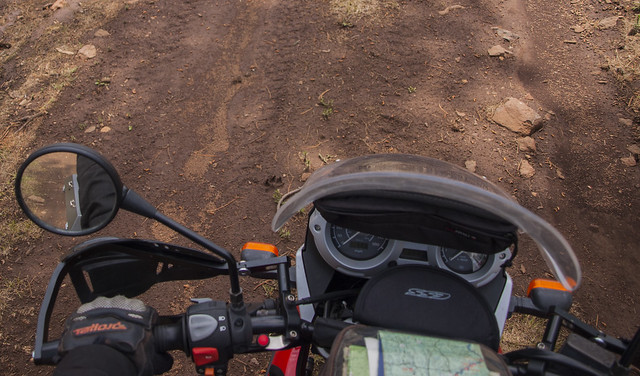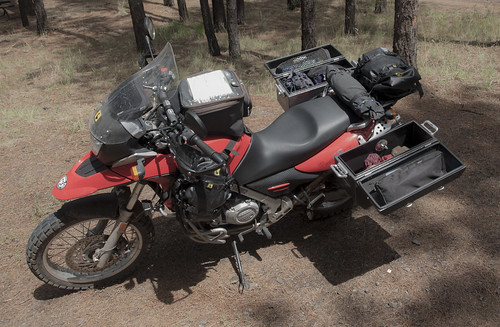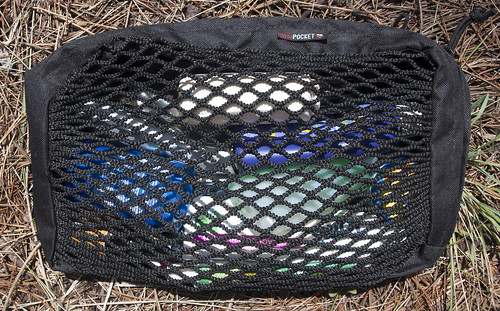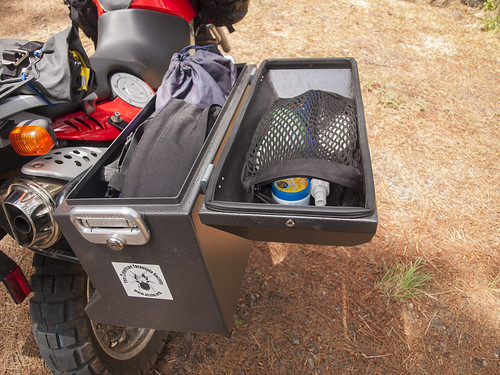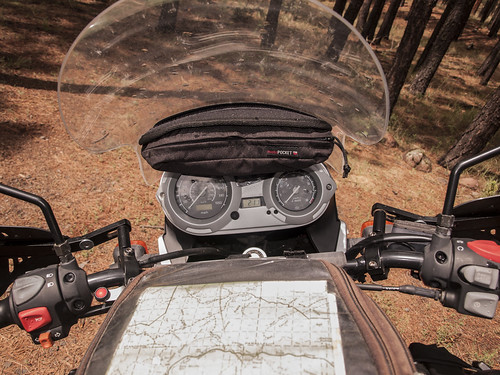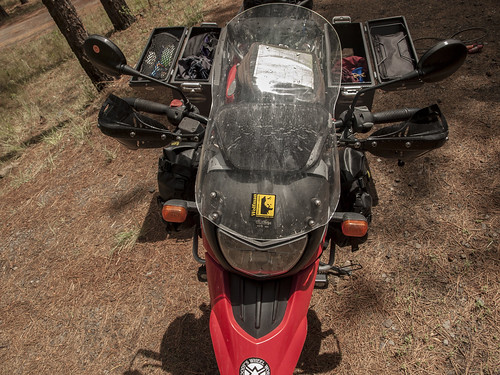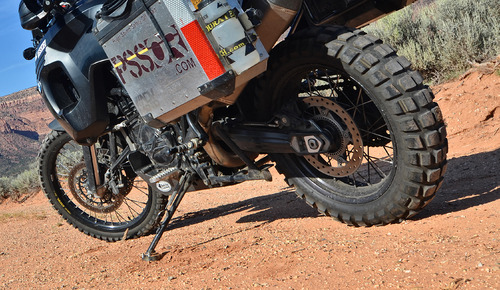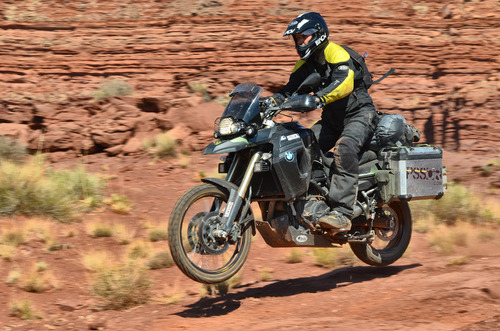
Overland Tech and Travel
Advice from the world's
most experienced overlanders
tests, reviews, opinion, and more
Inflate tires with your Micro-start
I make no secret of my continually renewed admiration for Antigravity Batteries’ Micro-Start XP-1 and XP-10 battery pack/jump-start kits. The half-dozen or so of them scattered among the Overland Expo training team have been used and abused beyond reason, and they continue to function. We’ve started everything from motorcycles to 460-cubic-inch gasoline engines to turbodiesels. We’ve hooked three in series and produced excellent field welds (much to the horror of company president Scott Schafer). We make sure one is in any vehicle we’re driving.
Motorcyclists have begun carrying the smaller XP-3 and XP-5 Mini, freeing them as well from the tyranny of jumper cables or the need for a good Samaritan if caught with a discharged battery. Now Antigravity has come up with a cunning little air compressor, about the size of a sandwich, that can either be powered from a Micro-Start battery or plugged into a standard cigarette lighter socket.
I expected it to perform as well as the company’s other products, and it did: A quick test on Roseann’s R80 G/S took the front Continental 90/90-21 tire from 8 PSI to 35 PSI in two minutes flat, and the compressor didn’t even get warm doing so. The inflation hose is only about three inches long, so the pump simply hangs off its screw-on chuck. A dedicated 18-inch cord connects it to a Micro-Start power source (I used our XP-1); the ten-foot cigarette-lighter cord is long enough to reach into a vehicle or to another motorcycle.
Of course, since this is a Micro-Start product, there's by now a certain assumption we'll abuse it. So I left the compressor hooked up to the power pack and connected it to a 235/85 16 BFG AT KO2 on our Tacoma. Ambient temperature was 95ºF. The tire was at 20 PSI; 16 minutes and 30 seconds later it had reached its nominal 40 PSI, and the compressor, while quite warm to the touch, was still buzzing away happily. The power pack still showed three of five status lights. So, while I certainly wouldn't use this as a primary compressor for a four-wheeled vehicle, in a pinch it would suffice.
What more can I say, except I hope the manufacturer edits the features list on the box. The tire inflator is yet another excellent offering from Antigravity Batteries. And at $25 it is a bargain.
Project: “Wolf Bike” gets a motoPOCKET upgrade
Earlier this year, Steve Dibble donated a 2006 BMW F650GS to Overland Expo’s charity organization, ConserVentures, whose mission is to promote exploration and to conserve our natural and cultural heritage. In an effort to support field work for the endangered Mexican gray wolf, the bike ended up in the hands of Craig Miller, the Southwest representative for Defenders of Wildlife and a lifelong motorcycle enthusiast. Craig has been a tireless advocate for wildlife conservation in the Southwest for over 30 years. [For more details, please see his bio here.]. Craig’s work takes him deep into Arizona and New Mexico backcountry on rugged forest roads. The Wolf Bike allows him to move more quickly and efficiently, covering more ground to engage people in wolf conservation. "It’s helped me maintain a more consistent presence in the field, and the rides between ranches keep me energized for the difficult visits."
Part of the Wolf Bike project is to properly outfit the bike for such remote and rugged conditions. At Overland Expo WEST 2014, the Wolf bike received donations from Jesse Luggage (panniers), RawHyde Adventures (set of tires), Baja Design (lighting), Wolfman Luggage (dry bag), Kinder Rider (LS2 helmet), Woody's Wheel Works and Ironhorse BMW. In addition, Bob Allen of Adventure Pockets donated and installed three motoPOCKETs on the Wolf Bike project: The motoPOCKET Windshield (11 x 7 x 2 in.), The motoPOCKET Side Case (14 x 6 x 2 in.) and The motoPOCKET Side Case with netting (14 x 6 x 2 in.). With convenience and durability in mind, MotoPOCKETs are a universal size and attach with heavy-duty Velcro to create an on-board storage solution.
The Side Case pockets fit perfectly width-wise on the underside of the Jesse Luggage panniers outfitted on the Wolf Bike. Although it doesn’t take up the entire length of the pannier lid, the space leftover allows taller items—such as a rolled Thermarest—to nestle beside it when closed. The Side Case pocket comes with or without a durable netting. The netting version is slightly expandable and provides more volume to hold supplies while keeping everything visible. Craig notes, “I was a little skeptical at first, but I now really appreciate how convenient it is to have frequently used accessories in known locations, and that are easy to access. No more digging through piles of jumbled gear hoping to grab the right thing.”
Even though the pockets stay secured with Velcro, they are easy to remove when unpacking at camp for the night. Craig uses them to store items such as camera batteries, SD cards, or other items that can be easily transferred to a backpack once at the trailhead, and for personal hygiene supplies for a quick freshen-up between miles. When storing heavier items, such a batteries or small tools, the Jesse retaining clips help keep the pocket and items in place.
The Windshield pocket mounts inside of the windscreen and fits into the area between the Cee Bailey windscreen and instrument gauges. It does not impair visibility of the road or trail at all, but there is a slight impairment to the warning lights. Craig likes the convenience of the windshield pocket so much he tends to overstuff it – wallet, small journal, sunglasses, keys, tire gauge, hex tool and GPS – especially when he is not using a tank bag. The weight of items pull the case down in front of fuel and turn signal indicator lights, even when only partially full and more so off pavement
Luckily, there is a simple fix. Craig modified the windshield attachment by adding longer rubber top mounts, which increased the space between the windshield and the gauges by about 1-½ inches, then reattached the motoPOCKET mount lower on the windshield. This slightly reduced motoPOCKET volume, but solved the visibility issue.
Craig’s conclusion? “I’ve only used for 4,500 miles, but they’ve already taken abuse and are no worse for wear…Overall, I am really happy with Adventure Pockets motoPOCKETs. They’re a high-quality, well-thought-out product that truly provides an onboard storage solution with ‘at your fingertips convenience.’ They’ve definitely helped keep me better organized and prevent me from wasting time looking for the things I consistently need to access.”
Thanks to the supporters of the Wolf Bike project: Adventure Pockets, Jesse Luggage, Baja Designs, RawHyde Adventures, Wolfman Luggage, Kinder Rider, Woody's Wheel Works, and Ironhorse BMW. Would you like to support the Wolf Bike project? You can donate one or more items on our wish-list. In return, we’ll feature your business in the Wolf Bike booth and at the Wolf Bike presentation at Overland Expo. Contact Overland Expo about opportunities.
Summer’s Not Over Yet: Three ways to beat the heat while motorcycling
You want to go ride, but the temperature read out on your motorcycle shows you near triple digits. Then you look at your gore-tex infused or ballistic nylon suit and wonder how you are going to be comfortable enough to do it? Body heat regulation is an important factor to consider for any ride, and a cooling vest may be the answer you are looking for.
Unlike most who are counting down the last days of summer, I live in a location where it’s hot and humid year round. I am constantly on the search for how to keep cool while I ride. In addition to consistent hydration, I have found a cooling vest to be a good solution to the heat.
When I stay local and practice slow (under 15 mph) motorcycle exercises on the weekends, I wear a Leatt Coolit vest under Klim’s solstice base layer (the high neck hides the vest), and then modular protective gear on top of that. The cut of the vest is made for a man, but does fit the curves of a woman well and true to size. All the cooling vest needs is a quick 5 min soak in the sink, a good squeeze to remove the excess water and it’s ready to wear. The vest retains water for a few hours, depending on heat, body heat, and humidity. Where I live, on average, is 80% humidity and the “coolness” lasts for about 2-3 hours during hot 90F weather. After about two hours, the vest is still damp, but has warmed up to my body temperature and lost its cooling effect. I keep cold water with me and will drench the vest again (while wearing it), but most of the time a fast lap or two around the block helps. > Read full article here.
Lynx tie-down straps
Update on January 13, 2015. I just learned that Lynx will have a booth at Overland Expo WEST this May, so you'll be able to see this clever tie-down system in action and pick up a set or two.
I hate cargo nets.
Every one I’ve had the misfortune to use has proven itself unwieldy, snarl-prone, and impossible to adjust to achieve uniform tension across bulky and mismatched baggage. Yet there are many situations in which standard ratchet straps simply will not work. And doing without is not an option—if, God forbid, you find yourself in a road accident or a rollover situation on a trail, it would be embarrassing if your shoulder belts and air bags all worked perfectly to save you, and a flying camera bag or camp stove gave you a concussion, or worse.
The Lynx tie-down straps are the answer to a lot of those situations.
Each Lynx tie-down comprises an adjustable nylon strap, a short length of solid-natural-rubber elastic sheathed in polyester, a quick-release Fastex-like buckle, and a plastic hook on each end. Okay, so what? Here’s the trick to the patented straps: The cunning hooks can be snapped together to create a completely customized web suited to almost any pile of cargo you need to secure. Each one adjusts from 19 to 45 inches in length, but you can also join them end to end to create almost any length you need.
The hooks snap together . . .
I gathered up a motley assortment of Pelican cases, range bags, and camera bags, and had no problems quickly assembling a five-legged spider of Lynx straps to secure the pile to the tie-down loops in the back of my FJ40 (of course a prerequisite for the straps to work is a decent array of strong tie-down loops in your cargo area). If I’d been doing the same thing in the back of a long-bed pickup, I could have assembled two spiders and joined them with a connecting strap. The configurations are limited only by your imagination.
. . . to lengthen a strap or create a web.
The adjuster buckle on each strap makes one-hand snugging of cargo easy, and the elastic section assures that a rough road or a load that manages to settle won’t allow a hook to come loose. It also make unfastening the system simple without the necessity of loosening the adjuster or unfastening the buckle. Given that elastic component, the Lynx straps can’t be considered replacements for full-on ratchet straps. I wouldn’t secure a line of full jerry cans against a bulkhead with only these, nor would I trust them to immobilize my 60-pound Pelican case full of tools in a collision (the company conservatively rates them at 25 pounds each; a web should handle a corresponding multiple of the individual rating). But the straps seem perfect for securing clothes duffels, camera bags, tents, stoves, and the like—all those sundry items that go in on top after you’ve ratchet-strapped the really heavy stuff.
Best of all, if you just need a couple of straps for, say, securing a sleeping bag to a motorcycle seat, just disassemble your FJ40 spider and there you go. Or hook four or five inline to create a ridgeline for a tarp—and use extras to create guylines that give a bit in a breeze. The hooks will fit standard tarp grommets, and are large enough to grab most motorcycle luggage racks and the upper rails of many roof racks (if not, you can simply loop the strap around the rail and put the hook through it). Pondering further, I remember a roof tent I reviewed equipped with a fly that flapped in the mildest wind. A few Lynx straps would have solved that problem more effectively and with much less hassle than the paracord solution I devised..
As you can see, a half-dozen of these straps could come in handy in dozens of situations. And I’m free at last from cargo nets.
The Lynx website is here. (Just ignore the ATVs parked off the trail.)
Improving a KLR650 with a Seat Concepts custom seat
I first met Lendon of Seat Concepts when the office was in a small warehouse in San Jacinto, California. At that time, the company had just started manufacturing molded foam replacements for motorcycle seats. Since most of its employees come from a motocross background, the company has a vested interest in creating comfortable seats.
Eighteen months later, I saw Lendon again at the Overland Expo in Flagstaff, AZ and was able to catch up on how the business has grown. Seat Concepts has moved to a larger warehouse and now manufactures not only the foam and seat covers, but the seat pans as well, for some of the most popular models of adventure motorcycle (such as the KLR650). He is swamped with orders these days, so I appreciate even more the time he spent with me during the installation of my custom Seat Concepts seat back in October 2012. I had visited the shop with my 2003 Kawasaki KLR650 just before leaving on a 16,000-mile journey from southern California to the tip of South America.
Ergonomics are a big part of preparing your motorcycle for long stretches of miles or lengths of time. Dialing in the right set-up is critical. Adjusting where your hands grip on the handlebars, where your feet rest on the footpegs, or where your rear end sits on the seat, is a personal venture. But you will know when it’s uncomfortable and needs to be changed. Your butt is most likely the first place to let you know. I have tried the stock seat, which my mass molded to its shape instead of the other way around. I have tried a Corbin flat seat, which was like vinyl wrapped plank of wood. Neither was very comfortable for longer than half a day. In searching for an auxiliary cushion, the only supplement I found was a sheepskin seat cover by Alaska Leather. Out of habit more than function, the sheepskin came with me to South America. It did not last to the end of the trip because it was worn thin by so many years of use.
Having a custom seat built was probably the best (and most comfort-conscious) decision I made for the journey. Read more >
The LS2 MX453 Dual-sport Adventure helmet
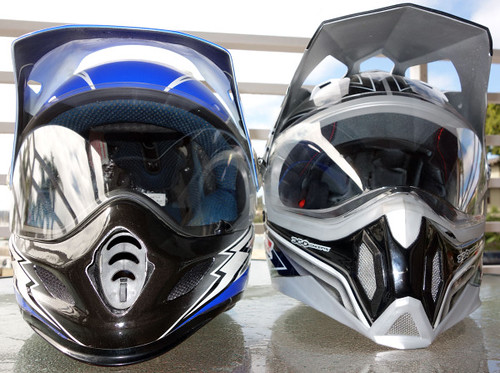 $400 Arai Xd-3, left; $160 MX453, right
$400 Arai Xd-3, left; $160 MX453, right
(Editor's note: Carla King recently conducted one of her typically thorough tests of a new and very affordable helmet from LS2, on a trip to Baja with Jonathan Ely. Thanks to Carla for the fine review.)
By Carla King
When my friend Reg Kittrelle asked me if I’d like to try an LS2 MX453 Dual-Sport Adventure Motorcycle Helmet I said, "I've never heard of it, but dual-sport adventure? I'm in!" I guess I have been living under a rock because LS2 sponsored 76 riders in the 2013 Dakar rally, including the winner Cyril Despres, and almost 100 riders in the 2014 rally. But the company has operated in stealth mode for quite some time, making helmets for well-known brands (as MHR helmets) before deciding to strike out on their own. They hired a Spanish marketing firm who set to work on design and style, then started selling factory direct to keep prices low. The MX453 Adventure costs only $169.95, undercutting name brands in the dual-sport adventure helmet market by hundreds while vastly surpassing the quality of other helmets in its price range.
The category "dual-sport adventure helmet" is defined by its hybrid components: a dual-sport or motocross style helmet with a large eye port covered by a flip-down shield where you’d normally wear goggles. These helmets also sport a visor to shield your eyes from the sun and an extended chin bar for breathing room and ventilation. All this so you can exercise your right to wrestle your bike through the dirt heading west at sunset. Here's Reg on YouTube explaining the "adventure helmet" concept.
The target market for this variation on helmets is riders like me with our single-cylinder dual-sport enduros like the KLR 650 and KTM 690, and the big-bore adventure motorcyclists with BMW and KTM Adventures and the skills for off-tarmac fun. I see another great market in riders of the smaller dual-sport bikes who set off across the Sahara all the way to Cape Town, never exceeding 40 mph.
Touring helmets, like my Schuberth C3 modular (review HERE), by contrast, are targeted to long-distance tarmac riders attracted to speed and aerodynamics. In short, a visor, despite the sunshade, would only slow us down. But if you do both touring and dual-sport touring, your need for more than one purpose-built helmet is justified—along with a stable of motorcycles to match, of course.
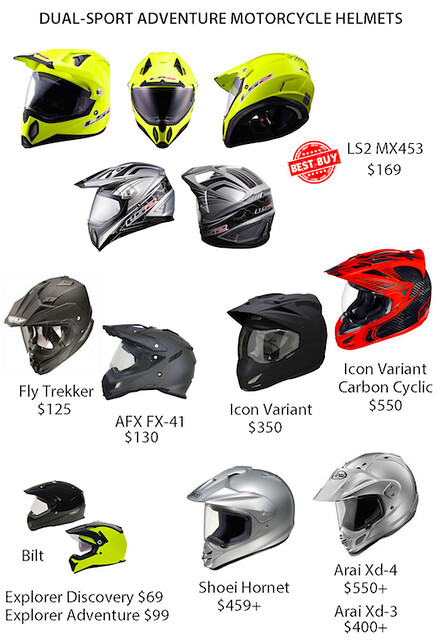
The LS2 MX453 arrived just in time for Jonathan Ely and me to take it along on a trip to Baja, trailering our KTM 350 and 450 EXCs. Jonathan, by the way, owns the pricy Arai XD-3 ($500) which made it easy to compare the Adventure feature-by-feature. (The new Arai XD-4 is available now.) For this review I also researched many other helmets in the dual-sport adventure category, doing some price and feature comparisons on the most popular. The two closest competitors are the Fly Trekker and AFX FX-41 in the $125 range. There really is no “mid-range” product in this category - though it could be argued that the LS2 would sit here if sold at a higher price via an intermediary. I did find the Icon Variant, which looks similar but is more a “hybrid” street helmet than a dual-sport helmet. One Variant is priced at $350 and the lighter carbon fiber model is $550. Then there’s the rock-bottom Bilt brand starting at an unbelievable $69. Finally you’ve got the brands on the highest ends, the Shoei Hornet and Arai Xd-4, both at over $550. There are many more but I just had to stop geeking out on this topic and finish this review.
In Baja, Jonathan and I unloaded the KTM dual-sports to explore backcountry and beaches, taking them for short rides down the tarmac at about 50 mph. We rode long stretches of remote sandy beaches and some scrabbly trails that usually dead-ended in impassible cactus-infested rock faces. Since the KTMs are unfaired I had expected the visor on the Adventure to catch the wind and throw my head back at tarmac speeds, but two very large diamond-shaped cutouts let the air through and prevented liftoff. Though Jonathan loyally defends his Arai, he had to admit that this was a thoughtful feature. Check out the photo comparing the two designs and you’ll see why I have less lift-off when riding at high speeds.
The MX453 Adventure’s fiberglass tricomposite shell also makes the helmet impressively light - not noticeably heavier than Jonathan’s size medium XD-3. My size small fit me perfectly and I found it very comfortable riding all afternoon. I haven’t used it for all-day touring yet but I think four or five hours at a time proves its wearability. The cheek pads are cut from one solid block of foam and other inner padding is smooth and substantial enough to keep my head from rattling around or making contact with any hard parts. There is also not any noticeable noise from the helmet itself, an irritation I’ve found with many lower-priced helmets.
When I took it for the first ride down Baja Highway One I was immediately struck by the view afforded by the ultra-large eye port they branded with the term “360 Concepts.” It actually gave me the startling feeling I wasn’t wearing a helmet at all. It was truly weird to feel as if there was nothing between my face and the road and I kept tapping the shield just to make sure. Soon there were a couple of bugs on it which eased my mind. This would also attest to the quality of the shield, which doesn’t distort the view. I wore my polarized Maui Jim sunglasses under the helmet with no discomfort. (My shield is clear but you can buy tinted shields.) Of course I also appreciated the visor to shade my eyes from the glaring Baja sun.
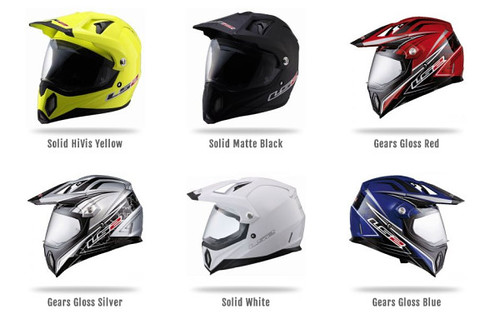
In the photo of the Arai and the LS2 side-by-side you can also see the large curved area at the bottom of the shield, which makes it easy to flip up no matter where you put your thumb. (But it also distorts your view when looking straight down, which didn’t really bother me.) The shield actuation is incredibly smooth and it stays where you put it. Many other helmets have one small visor-lift tab placed on the left side. The shield actuation on the Arai is on the firm side, and it’s sealed with a substantial gasket. The only irritation I’ve had with the MX453 so far is that the flimsy gray gasket has already started to pull away on the left side where my thumb rubbed when I pushed up the shield. (You can also see that in the photo.) Since I ride in San Diego and Mexico I wonder if that’s a result of the glue drying out in our consistently dry weather conditions. It’s nothing that a new application of glue won’t fix, and I’m not trying to compare it directly to the Arai, which of course is three times the price. That said, you’ll notice that Jonathan’s front vent went missing in Baja, again, possibly due to hot dry conditions drying out the glue. Oh, the sacrifices we make for living in Southern California!
The venting on the Adventure was adequate with a more airy feel than any other motocross helmet or conventional helmet I’ve ever worn. This might be more indicative of this style of helmet than the LS2 specifically, since they’ve all got the motocross helmet style breathing room and a shield instead of goggles pushing against your face. Speaking of goggles, other reviewers have noted that it’s much easier to fit goggles under the shield on the Adventure than other brands. (The shield is also easy to remove if you want to wear googles only.) There’s a lot of room in the chin bar for heavy breathing which is so much appreciated when working hard to get the bike through rocks and sand. A switch inside the chin bar controls the front vents, and two vents on top are also switchable. I could feel airflow through the chin and top of the head all the way to the exhaust vents at the back.
You can buy the LS2 MX453 Adventure helmet at online dealers and even at Amazon, along with replacement padding, shields, and visors. The sizes seem "true" and it was an easy fit with no pressure points - which is the impression other reviewers have had as well.
Jonathan bought his $500 Arai because it’s the quietest dual-sport adventure helmet available and it’s also got very high safety ratings. Comparatively, the $160 Adventure seems quiet enough and in fact one respected reviewer found it quieter than the Shoei Hornet. Nevertheless, I still wear earplugs (which I don’t always wear with my Schuberth C3) because the KTM is louder and buzzier than my other bikes and of course I ride off-pavement at higher RPMs.
The MX453 Adventure is DOT and ECE approved but not Schnell approved, but if it’s good enough for Europe it’s good enough for me. The chinstrap is nicely padded and has a standard D-ring closure system. (But I do wish everyone would go to the European ratchet system that I’ve grown so fond of on my Schuberth C3.)
When you compare the Adventure feature-by-feature with other helmets in this price range it quickly becomes apparent that this is the best buy by far in the low to mid-priced group. This may be a result of the factory-direct distribution which cuts out the intermediary sales channel. The new Arai Xd-4 at over $500 is generally considered as the best in this category, and it is proven the quietest. But of course if you have a Shoei head (and $500), you’d spend your money with them. If you’re super price conscious you might be tempted by the Bilt helmet at an amazingly low $69, or the popular ACX or Fly models at $30 less. But after a few casual try-ons at motorcycle stores, and after researching expert opinions around the web, I’ve come to the conclusion that spending the $160 on the LS2 MX453 Adventure would be the wisest investment.
I’m really glad Reg at LS2 approached me to test out this helmet. It is perfect for my style of riding, which is mainly adventure touring on the KLR and the R100GS, and dual-sporting on the smaller KTM 350 EXC. Heck, I might even try it when riding my big Moto Guzzi cruiser, so that on my rides from Borrego Springs back home to San Diego the visor shelters me from the glare of the setting sun.
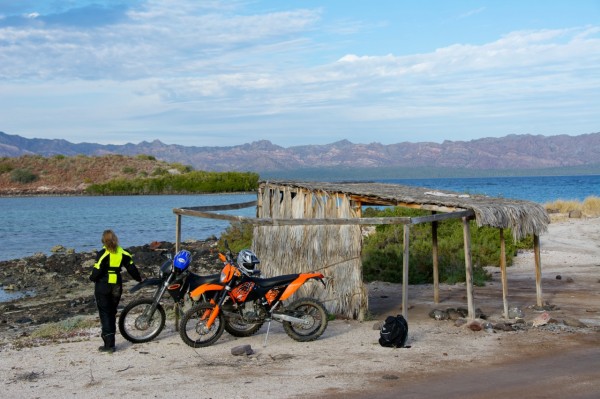
LS2 is HERE.
23,000-mile review: Klim Latitude jacket and pants
 Pockets galore! (on the Altiplano in Peru)
Pockets galore! (on the Altiplano in Peru)
As a female motorcyclist, choosing a viable suit for long-term riding is met with limited options. Despite the growing industry for women’s gear, what was available in October of 2012 did not equate to the durability and versatility of men’s gear. I looked at comparable manufacturers such as Rev-it and Alpinestars (I rode a KLR, so the BMW brand was not even considered), but neither of those held up to what I wanted out of a suit I was going to live in for six months. So, while preparing for a motorcycle journey from Los Angeles, California to Ushuaia, Tierra del Fuego, I decided on Klim’s Men’s Latitude jacket and pants.
In my initial review after six days of test riding around California before I left, my response was, “Yay! Klim is so great!” But just like any new relationship, I was excited at the potential of what could be, not scrutinizing what I had in front of me. So now, 15-months and more than 23,000 miles later, it’s time to break down the long-term, grime-covered, down and dirty results...
 Latitude 0 (at the Equator in Ecuador)
Latitude 0 (at the Equator in Ecuador)
Continue reading full article here.
Tire review: Big Block Adventure
by Bret Tkacs, for Adventure Motorcycle Magazine
In early 2012, Kenda released the Big Block Adventure tire to compete in the emerging big-bike knobby market. ADVMoto put a set of Big Blocks to the test on the back trails of Baja, Mexico, and then continued north up the west coast to Washington state. Back then, the Big Blocks were good performers, and on par with the competition, but lacked mileage and shed their skins faster than other big-bike knobbies we’re accustomed to, such as the TKC80 and Metzler Karroo. Kenda took note of this and their engineers worked over the Big Block with a revised tread pattern and new compound.
The casual eye won’t see the difference, as the tread pattern looks very similar. The only way we could tell they were the new tires was by measuring the space between the tread blocks. The newer tires have a block pattern slightly tighter, which puts more rubber to the road/trail.
We recently mounted up our fresh set of tires and headed off to Moab to put them to the test. After riding 800 miles of jeep trails and gravel roads, as well as over 2,000 miles of pavement on our loaded test bike, the Big Blocks were still holding out.
The bottom line is that Kenda has a winner with good off-road performance, good street manners, and mileage that equals the competition. Highly recommended.
Pros:
- Still a top performer off-road
- Performs well for a knobby on the street
- Improved mileage over earlier version
- Price point winner
Cons:
- Less prestige than big name brands (ego)
- Like all big bike knobbies it has a short life span (equal to other knobbies, though)
Bret Tkacs works for PSSOR Training
Hint: When using “Search,” if nothing comes up, reload the page, this usually works. Also, our “Comment” button is on strike thanks to Squarespace, which is proving to be difficult to use! Please email me with comments!
Overland Tech & Travel brings you in-depth overland equipment tests, reviews, news, travel tips, & stories from the best overlanding experts on the planet. Follow or subscribe (below) to keep up to date.
Have a question for Jonathan? Send him an email [click here].
SUBSCRIBE
CLICK HERE to subscribe to Jonathan’s email list; we send once or twice a month, usually Sunday morning for your weekend reading pleasure.
Overland Tech and Travel is curated by Jonathan Hanson, co-founder and former co-owner of the Overland Expo. Jonathan segued from a misspent youth almost directly into a misspent adulthood, cleverly sidestepping any chance of a normal career track or a secure retirement by becoming a freelance writer, working for Outside, National Geographic Adventure, and nearly two dozen other publications. He co-founded Overland Journal in 2007 and was its executive editor until 2011, when he left and sold his shares in the company. His travels encompass explorations on land and sea on six continents, by foot, bicycle, sea kayak, motorcycle, and four-wheel-drive vehicle. He has published a dozen books, several with his wife, Roseann Hanson, gaining several obscure non-cash awards along the way, and is the co-author of the fourth edition of Tom Sheppard's overlanding bible, the Vehicle-dependent Expedition Guide.

